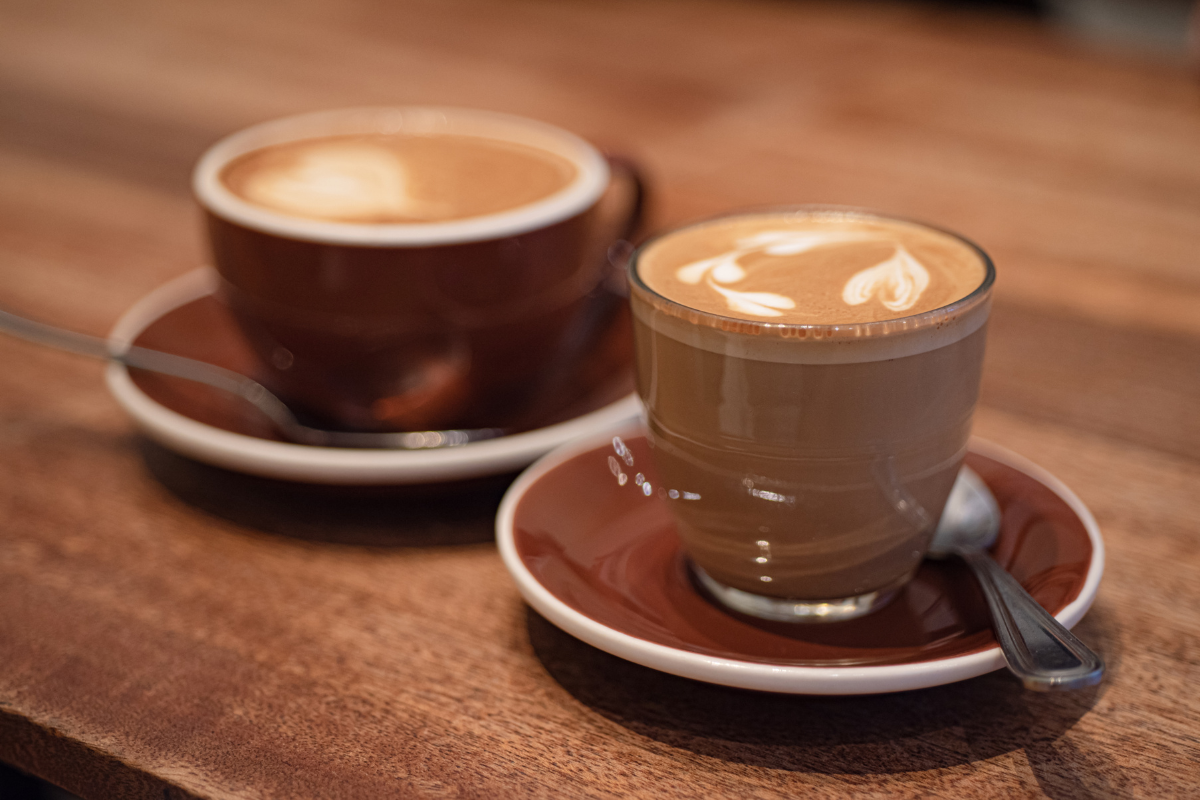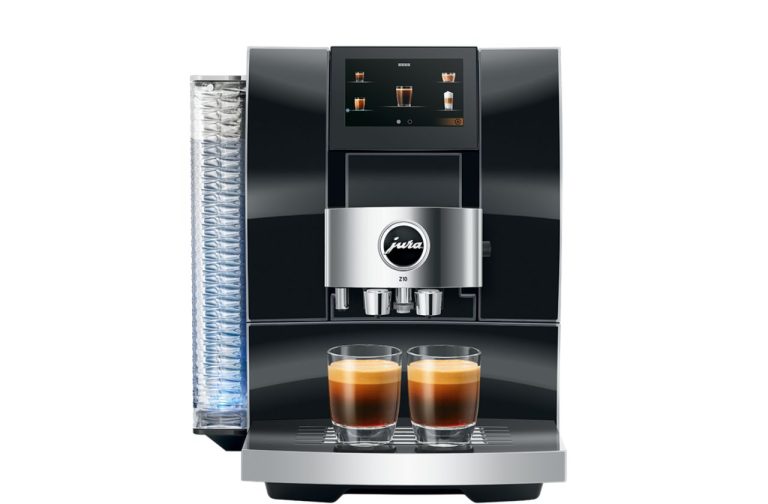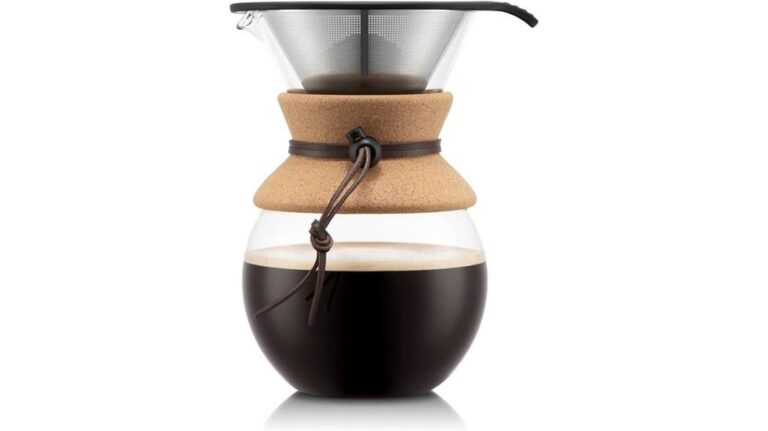Flat White Vs. Cortado
From bustling urban coffee shops to quiet suburban cafes, the conversation around coffee has shifted from mere caffeine consumption to a deeper appreciation of the artistry and cultural significance behind every cup. Among these myriad styles, two have notably risen in popularity, capturing the hearts of coffee enthusiasts worldwide: the Flat White and the Cortado.
A Flat White is a creamy coffee made with a double shot of espresso and microfoamed milk, noted for its smooth texture. A Cortado balances espresso with equal parts warm milk, offering a bolder flavor. Both drinks highlight espresso but differ in milk ratio and texture.
Whether you’re a seasoned barista, a home brewer, or simply a lover of a good cup of joe, grasping the subtleties between a Flat White and a Cortado can enhance your appreciation and open up new avenues in your coffee exploration journey. Join us as we embark on this flavorful adventure, unraveling the mysteries behind these two iconic coffee styles.
Flat White Vs. Cortado
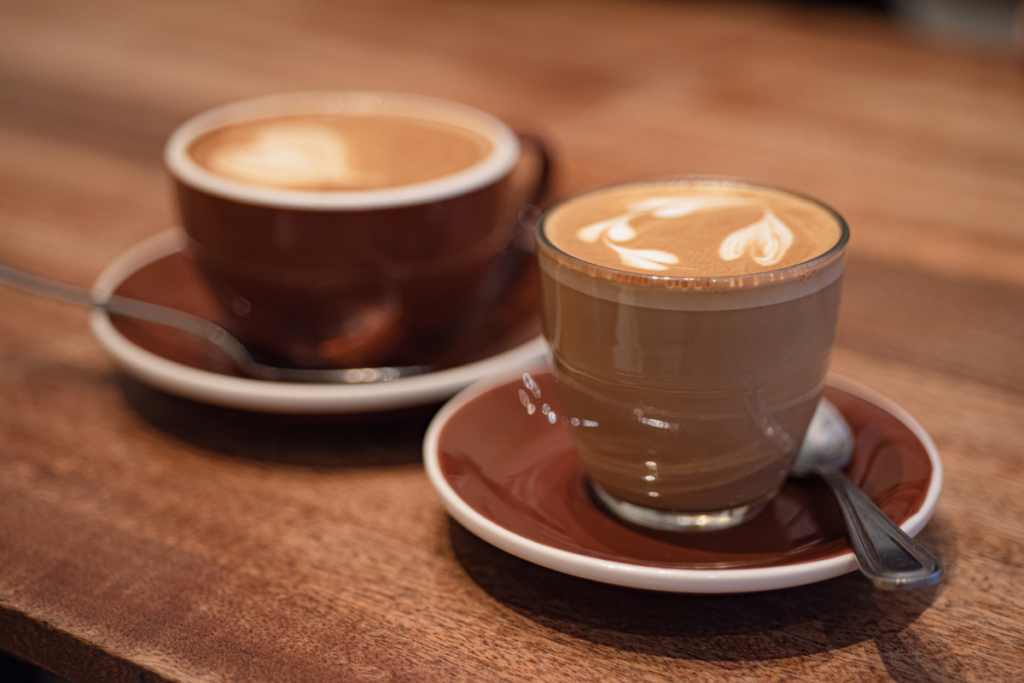
The Flat White, with its roots deeply embedded in Australian and New Zealand coffee culture, and the Cortado, a staple in Spanish and Portuguese coffee traditions, offer more than just a caffeine kick.
They are distinct expressions of coffee craftsmanship, each with a unique story, brewing technique, and taste experience. By comparing and contrasting these two beloved coffee styles, we delve into the nuanced world of espresso and milk, exploring how slight variations can create remarkably different sensory experiences.
In the diverse universe of coffee, the Flat White and Cortado stand out as two popular choices, each offering a unique experience to the discerning palate.
At first glance, these drinks may seem similar, both hailing from the espresso-based coffee family and involving a delicate balance of espresso and milk. However, a deeper exploration reveals key differences that define their distinct characters.
The Flat White, a creation often credited to Australian and New Zealand coffee culture, is a smooth, velvety beverage made with a double shot of espresso and a layer of microfoamed milk.
The milk in a Flat White is steamed to a creamy consistency, lacking the stiff foam often found in cappuccinos, which allows for a rich, integrated texture and flavor.
The Cortado, on the other hand, has its roots in Spanish coffee traditions. This drink typically consists of an equal ratio of espresso to warm milk, designed to cut (hence the name “Cortado,” which means “cut” in Spanish) the acidity and intensity of the espresso.
The milk in a Cortado is usually less foamy compared to a Flat White, with an emphasis on maintaining the espresso’s robust character.
The primary distinction between these two lies in the milk-to-espresso ratio and the treatment of the milk. The Flat White, with its double shot of espresso and larger volume of microfoamed milk, presents a creamier, more milk-forward flavor profile. The microfoam also adds a silky texture, making the drink smoother.
In contrast, the Cortado’s equal parts of espresso and milk emphasize the espresso’s strength, offering a bolder, more pronounced coffee flavor. The milk tempers the espresso’s bitterness without overpowering its inherent characteristics, leading to a more balanced and less creamy beverage.
Despite their differences, both drinks share a common foundation: the desire to harmonize the boldness of espresso with the softness of milk. They avoid the heaviness of larger milk-based coffees like lattes and lean towards highlighting the espresso’s qualities. This middle ground makes them favorites among those who appreciate a strong coffee flavor with a touch of milk.
When comparing the two, the Flat White is often described as smoother and creamier, making it a perfect choice for those who enjoy a milkier coffee without the frothiness of a cappuccino.
The Cortado, with its more robust and straightforward coffee flavor, is ideal for espresso lovers who seek a milder version of a straight shot without straying too far from the espresso’s core profile.
Drinking a Flat White is an experience in texture as much as taste.
The silky microfoam combines seamlessly with the rich espresso, creating a luxurious and comforting sensation. On the other hand, sipping a Cortado feels more direct and unadorned, where the espresso’s vibrancy is at the forefront, mellowed just enough by the warmth of the milk.
Whether you choose a Flat White for its creamy indulgence or a Cortado for its straightforward coffee punch, both beverages offer a unique and enjoyable coffee experience, each with its own character and appeal.
Weird Coffee Tip: The world of espresso drinks can be confusing to navigate. Sometimes, we need a little extra help understanding coffee drinks. This article on espresso-based drinks can help bring much-needed clarification.
Types Of Espresso Drinks
What Makes These Drinks Unique?
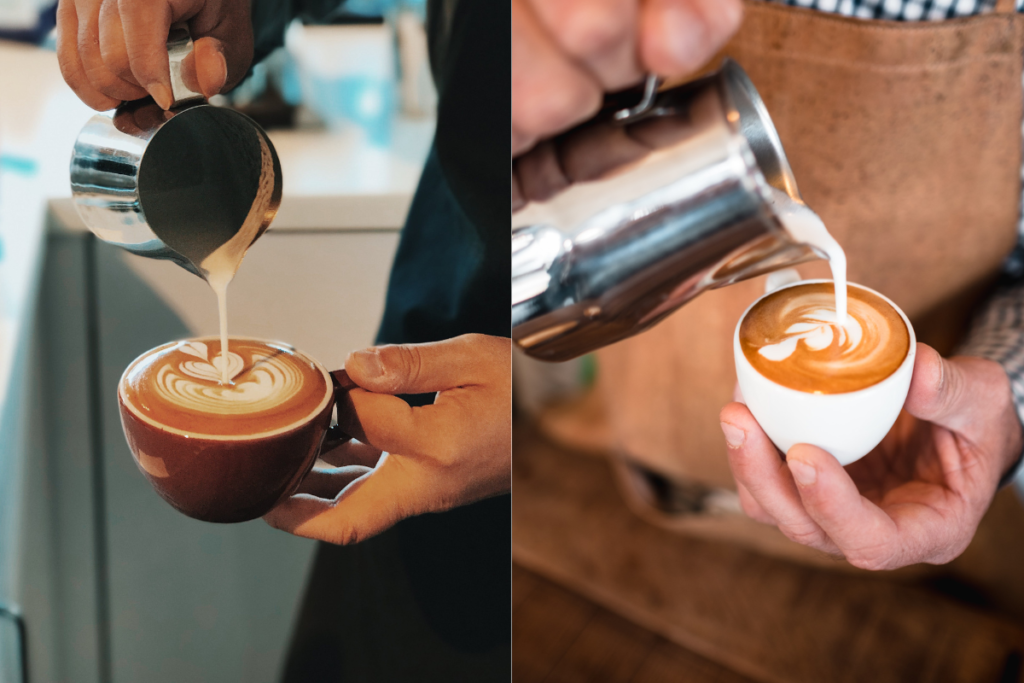
The Flat White and the Cortado share some basic ingredients and brewing techniques, but when looking more closely at what makes these drinks unique, their differences become more apparent.
Let’s explore what makes the Cortado and the Flat White unique in the wide world of espresso-based coffee drinks.
Ingredients and Proportions
The Flat White is a harmonious blend of strong espresso and velvety milk. Typically, a Flat White is crafted with a double shot of espresso and a larger proportion of steamed milk than found in a Cortado.
This ratio, usually around two-thirds milk to one-third espresso, creates a beverage where the creaminess of the milk complements rather than overwhelms the robust espresso base. The milk’s texture is key; it’s steamed to create a fine microfoam that blends seamlessly with the espresso, resulting in a smooth, rich coffee experience.
This careful balance ensures that the espresso’s bold flavors are present yet softened by the milk’s creamy texture, creating a drink that is both robust and delicate.
In contrast, the Cortado takes a different approach to this balance. Traditionally, it is made with an equal ratio of espresso and steamed milk. This 1:1 ratio highlights the espresso’s flavor, allowing its natural characteristics to shine through while the milk cuts its acidity and intensity.
Unlike the Flat White, the milk in a Cortado is not heavily foamed, resulting in a less creamy texture and a more pronounced coffee flavor.
The reduced milk content in a Cortado ensures that the espresso remains the star of the show, offering a bolder taste that appeals to those who prefer their coffee strong but slightly softened.
Brewing Techniques
The brewing technique for a Flat White is as crucial as its ingredients. The espresso used is often a ristretto, a concentrated espresso shot that provides a more intense flavor.
This choice of espresso shot is essential to maintain the coffee’s presence amidst the larger volume of milk. The steaming of the milk is also a delicate process; it requires creating a smooth, velvety microfoam that is free from large bubbles and integrates perfectly with the espresso. The barista’s skill in achieving the right texture of milk is pivotal in crafting an authentic Flat White.
Brewing a Cortado, meanwhile, involves a different set of nuances. The espresso in a Cortado is usually a standard shot, emphasizing the natural flavors of the coffee beans. The milk, warmed but not overly foamed, is then added to the espresso in equal parts.
This simplicity in preparation keeps the focus on the coffee, with the milk acting as a gentle complement rather than a transformative ingredient. The art of the Cortado lies in its understatement, where the skill of the barista is shown through the perfect extraction of the espresso and the subtle warming of the milk to achieve a harmonious blend.
The uniqueness of both the Flat White and Cortado lies in their distinct approaches to combining espresso with milk. The Flat White offers a creamier, smoother experience, while the Cortado provides a more direct, coffee-focused taste, each reflecting different cultural approaches to the beloved ritual of coffee drinking.
Popular Variations and Customizations
The Flat White, while having its roots in Australia and New Zealand, has been embraced and adapted by coffee cultures around the world, leading to interesting regional variations.
North American Twist: In the United States and Canada, the Flat White is often made with a single shot of espresso instead of the traditional double shot, catering to local preferences for a milder coffee flavor.
Additionally, some cafes offer alternative milk options, such as almond, soy, or oat milk, to accommodate dietary preferences and add a unique flavor profile.
European Interpretation: In Europe, particularly in the UK, the Flat White has become synonymous with artisan coffee culture. Here, baristas may use locally roasted beans to give the Flat White a distinct regional flavor. There is also a trend towards using organic or locally sourced milk, which can alter the taste and texture of the final product.
Asian Variations: In Asia, particularly in metropolitan areas like Tokyo and Seoul, the Flat White is often served with a twist of local flavors, such as matcha or yuzu, adding a unique and regionally inspired taste to the drink.
The Cortado, traditionally a simple blend of espresso and warm milk, has also undergone various customizations, adapting to local tastes and trends.
Flavored Cortados: In some regions, particularly in the United States, Cortados are occasionally infused with flavored syrups such as vanilla, caramel, or hazelnut, adding a sweet twist to the traditionally robust coffee.
Iced Variations: Given the popularity of iced beverages in many countries, the Cortado has also been adapted into an iced version. This involves either pouring the traditional Cortado over ice or using cold brew coffee instead of espresso, offering a refreshing alternative to the classic warm drink.
Alternative Milk Options: Similar to the Flat White, Cortados are now often available with a variety of milk alternatives. Options like coconut, almond, and oat milk not only cater to dietary restrictions but also add distinct flavors and textures, creating a new coffee experience for the consumer.
Specialty Coffee Beans: Enthusiasts and specialty coffee shops sometimes experiment with different single-origin or specially roasted beans for Cortados, focusing on how the unique flavors of these beans interact with the milk.
In conclusion, both the Flat White and Cortado have evolved beyond their traditional recipes, embracing regional tastes and trends. These adaptations not only reflect the diversity of global coffee culture but also highlight the versatility and enduring popularity of these beloved coffee styles.
Conclusion

Throughout this exploration of the Flat White and Cortado, we’ve delved into the intricacies that make each of these coffee styles unique and celebrated in their own right.
The Flat White, with its roots in Australian and New Zealand coffee culture, offers a creamy, velvety texture thanks to its higher milk content and the art of microfoaming. This drink is a perfect blend for those who savor a milky, smooth coffee experience without overwhelming the espresso’s robust character.
In contrast, the Cortado, hailing from Spanish and Portuguese coffee traditions, stands out for its straightforward approach to balancing espresso with a minimal amount of milk. This equal ratio creates a bolder coffee flavor, ideal for those who appreciate the strength and depth of espresso, lightly tempered by the warmth and slight creaminess of milk.
Each beverage showcases the versatility of espresso when paired with milk, yet they do so in distinctly different ways.
The Flat White leans towards a creamier, more textured experience, while the Cortado offers a more direct, espresso-forward taste. These differences underline the rich diversity in coffee preparation and consumption, reflecting not just regional preferences but also the individual palate.
As coffee enthusiasts, the exploration of these two styles offers a valuable window into the broader world of coffee. Trying both the Flat White and Cortado can deepen your appreciation of how slight changes in ingredients and techniques can yield significantly different sensory experiences.
Whether you’re in a cozy café or experimenting at home, we encourage you to experience both of these exceptional coffee styles. In doing so, you not only broaden your coffee horizons but also partake in a global community of coffee lovers who cherish every cup’s unique story and flavor.
